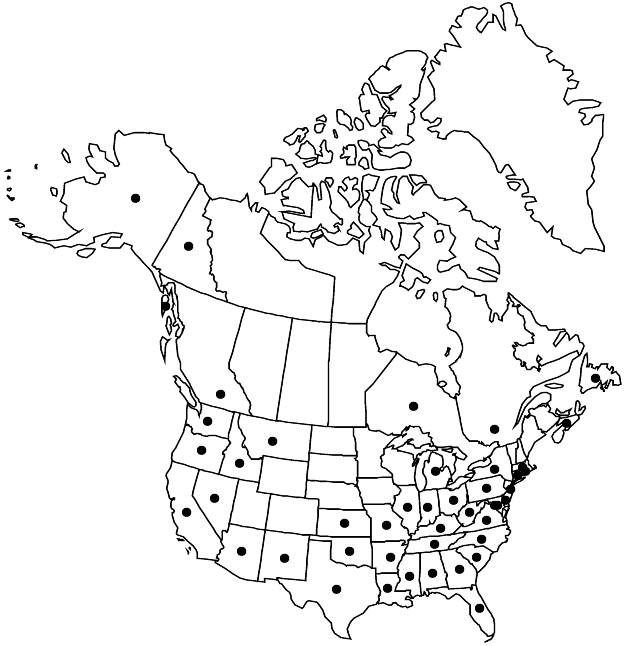Cerastium glomeratum
Fl. Env. Paris ed. 2, 226. 1799.
Plants annual, with slender taproots. Stems erect or ascending, branched, 5–45 cm, hairy, glandular at least distally, rarely eglandular; small axillary tufts of leaves absent. Leaves not marcescent, ± sessile; blade 5–20(–30) × 2–8(–15) mm, apex apiculate, covered with spreading, white, long hairs; basal with blade oblanceolate or obovate, narrowed proximally, sometimes spatulate; cauline with blade broadly ovate or elliptic-ovate. Inflorescences 3–50-flowered, aggregated into dense, cymose clusters or in more-open dichasia; bracts: proximal herbaceous, distal lanceolate, apex acute, with long, mainly eglandular hairs. Pedicels erect to spreading, often arcuate distally, 0.1–5 mm, shorter than capsule, glandular-pubescent. Flowers: sepals green, rarely dark-red tipped, lanceolate, 4–5 mm, margins narrow, apex very acute, usually with glandular hairs as well as long white hairs usually extending beyond apex; petals oblanceolate, 3–5 mm, rarely absent, usually shorter than sepals, apex deeply 2-fid; stamens 10; styles 5. Capsules narrowly cylindric, curved, 7–10 mm; teeth 10, erect, margins convolute. Seeds pale brown, 0.5–0.6 mm, finely tuberculate; testa inflated or not. 2n = 72.
Phenology: Flowering throughout growing season.
Habitat: Arable land, waste places, roadsides
Elevation: 0-1800 m
Distribution

B.C., Nfld. and Labr. (Nfld.), N.S., Ont., Que., Yukon, Ala., Alaska, Ariz., Ark., Calif., Conn., Del., D.C., Fla., Ga., Idaho, Ill., Ind., Kans., Ky., La., Md., Mass., Mich., Miss., Mo., Mont., Nev., N.J., N.Mex., N.Y., N.C., Ohio, Okla., Oreg., Pa., R.I., S.C., Tenn., Tex., Va., Wash., W.Va., Europe, introduced and common in Mexico.
Discussion
Cerastium glomeratum often has been reported as C. viscosum Linneaus, an ambiguous name; see discussion under the genus.
Selected References
None.